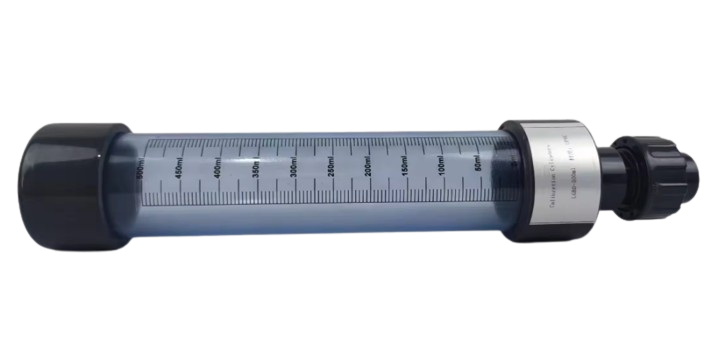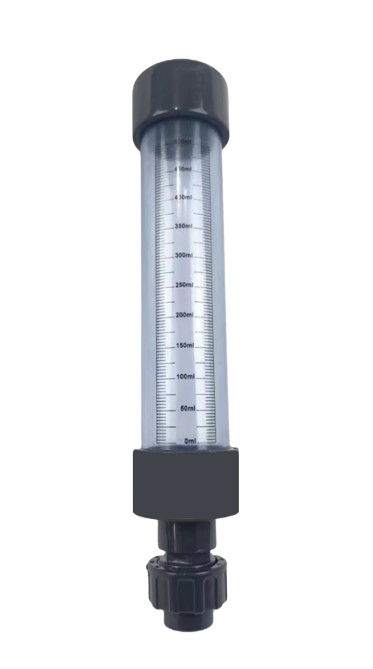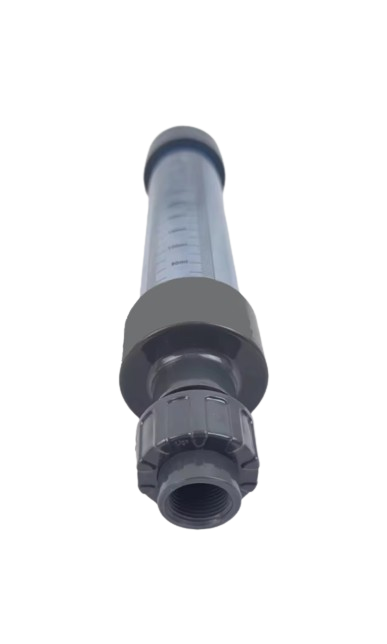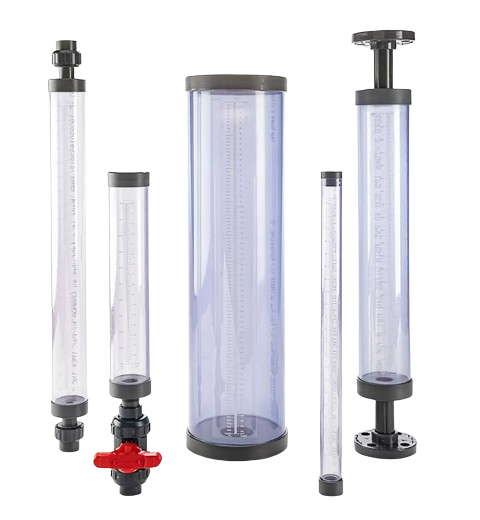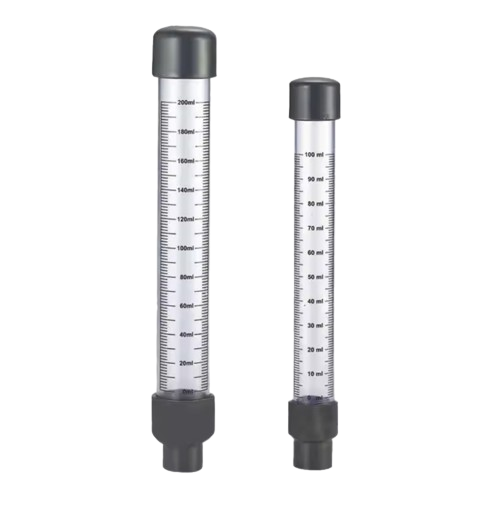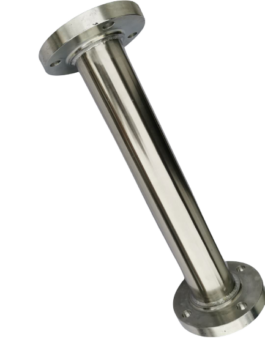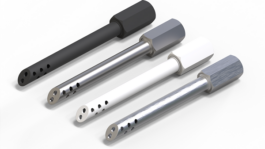Calibration Columns
$ 165.00 – $ 525.00Price range: $ 165.00 through $ 525.00
ProMixUSA pump calibration columns, also known as calibration cylinders, offer an efficient method for determining pump flow rates, displaying measurements in milliliters per minute (ml/min) and gallons per hour (GPH) using industry-standard graduations. Each column features top-aligned graduated scales, allowing operators to observe both ml/min and GPH in a single, one-minute test. The high-contrast blue lettering ensures readability in various lighting conditions, and a protective lamination layer safeguards the scales against chemical attack.
Calibration columns are available in two materials: borosilicate glass and PVC. Glass calibration columns are ideal for measuring the flow of corrosive chemicals and come with end caps made of CPVC, PTFE, or 316L stainless steel. In contrast, PVC calibration columns are a cost-effective option for non-corrosive or mildly corrosive chemicals.
Borosilicate glass columns are particularly suited for applications involving aggressive chemicals due to their superior chemical resistance and durability. The CPVC, PTFE, and 316L stainless steel end caps further enhance the compatibility and longevity of these columns in harsh environments. On the other hand, PVC calibration columns provide a budget-friendly alternative without compromising on accuracy and reliability, making them suitable for less demanding applications. Both types of columns are designed to deliver precise and reliable flow rate measurements, ensuring optimal performance and efficiency in various industrial settings.
Description
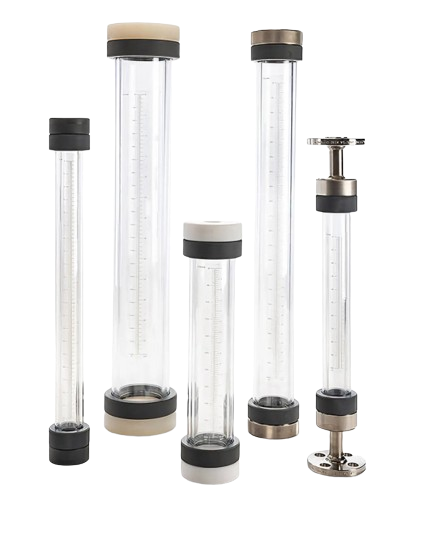 SRS pump calibration columns, also known as calibration cylinders, offer a precise and straightforward method for determining pump flow rates, using industry-standard graduations in milliliters per minute (ml/min) and gallons per hour (GPH). These columns are essential tools in various industrial applications, providing accurate measurements that ensure optimal performance and efficiency of pumping systems. This comprehensive description will explore the features, benefits, and applications of SRS pump calibration columns, with an emphasis on their construction materials, readability enhancements, and protective features.
SRS pump calibration columns, also known as calibration cylinders, offer a precise and straightforward method for determining pump flow rates, using industry-standard graduations in milliliters per minute (ml/min) and gallons per hour (GPH). These columns are essential tools in various industrial applications, providing accurate measurements that ensure optimal performance and efficiency of pumping systems. This comprehensive description will explore the features, benefits, and applications of SRS pump calibration columns, with an emphasis on their construction materials, readability enhancements, and protective features.
Function
The primary function of these calibration columns is to measure pump flow rates accurately. Each column is designed with top-aligned graduated scales that allow operators to monitor both ml/min and GPH in a single, one-minute test. This dual-scale feature is particularly beneficial for users who need to switch between different units of measurement quickly and effortlessly. The top-aligned scales also simplify the reading process, minimizing the risk of errors and ensuring that measurements are consistent and reliable.
One of the standout features of SRS pump calibration columns is the high-contrast blue lettering used on the graduated scales. This design choice significantly enhances readability in various lighting conditions, making it easier for operators to read measurements accurately. Whether in brightly lit environments or dimly lit areas, the high-contrast blue lettering ensures that the scales remain visible and legible. This feature is especially important in industrial settings where precise measurements are crucial for maintaining the efficiency and safety of pumping systems.
Protective Layers
In addition to their readability, the scales on SRS pump calibration columns are protected by a lamination layer. This protective layer serves multiple purposes: It prevents the scales from fading over time, shields them from physical damage, and protects against chemical attacks. In industrial environments where exposure to harsh chemicals is common, this protective layer ensures that the calibration columns remain accurate and durable. The lamination also makes the columns easier to clean, as it prevents chemicals and other contaminants from adhering to the surface of the scales.
SRS pump calibration columns are available in two primary construction materials: Borosilicate glass and PVC. Each material offers unique advantages, making the columns suitable for a wide range of applications.
Available End Cap Options
Borosilicate glass calibration columns are ideal for measuring the flow of corrosive chemicals. Borosilicate glass is known for its exceptional chemical resistance, making it a reliable choice for applications involving aggressive substances. These columns are available with end caps made of CPVC (Chlorinated polyvinyl chloride – Wikipedia), PTFE (polytetrafluoroethylene), and 316L stainless steel. Each of these materials offers additional benefits:
CPVC End Caps: CPVC is resistant to a wide range of chemicals, including acids, alkalis, and salts. It also has good mechanical strength and can withstand high temperatures. These properties make CPVC end caps a versatile and durable choice for many industrial applications.
PTFE End Caps: PTFE is renowned for its excellent chemical resistance and low friction properties. It is virtually inert to most chemicals, making it suitable for use with highly corrosive substances. PTFE end caps also have a high melting point, adding to their suitability for demanding environments.
316L Stainless Steel End Caps: 316L stainless steel offers outstanding resistance to corrosion, particularly in chloride environments. It also has excellent mechanical properties and can withstand high pressure and temperature conditions. These characteristics make 316L stainless steel end caps ideal for heavy-duty applications.
Precision
SRS pump calibration columns are designed to deliver precise and reliable flow rate measurements. Furthermore, ensuring optimal performance and efficiency in various industrial settings. These columns are essential tools for maintaining the accuracy and efficiency of pumping systems. These are critical components in many industrial processes. By providing accurate flow rate measurements, SRS calibration columns help prevent issues such as over- or under-dosing. When underdosing it can lead to inefficiencies, increased costs, and potential safety hazards.
The use of SRS pump calibration columns extends across a wide range of industries. In the chemical industry, accurate flow rate measurements are crucial for ensuring that chemical reactions proceed correctly and efficiently. In addition, it is in water treatment plants, calibration columns help monitor the flow of water and chemicals used in the treatment process. This ensures that we meet water quality standards. Finally, in the food and beverage industry, precise measurements are essential for maintaining product quality and consistency.
Environment
In addition to their practical applications, SRS pump calibration columns also contribute to environmental sustainability. By ensuring that pumping systems operate efficiently, these columns help reduce waste and minimize the environmental impact of industrial processes. Accurate flow rate measurements can lead to more efficient use of chemicals and other resources. Furthermore, reducing the overall consumption and disposal of hazardous materials.
Overall, SRS pump calibration columns are versatile, reliable, and essential tools for a wide range of industrial applications. Furthermore, their high-contrast blue lettering, protective lamination layer, and choice of durable materials. This makes them well-suited for accurate and reliable flow rate measurements in various environments. Whether used in the chemical industry, water treatment plants, or food and beverage production, SRS calibration columns ensure that pumping systems operate at peak efficiency. Furthermore, it contributes to improved performance, cost savings, and environmental sustainability.
Looking for Flow Meters? Visit our Parent company
Looking to Mix multiple feeds into a single output fluid? Visit our Static Mixers
Specifications
General Description
A calibration column is a vertical vessel used to accurately determine the concentration of a liquid solution through controlled flow and measurement techniques. It is essential for ensuring the precision of chemical dosing systems.
Materials
- Construction Material: Corrosion-resistant materials such as stainless steel or high-density polyethylene (HDPE).
- Seals and Gaskets: Compatible materials for chemical resistance, such as Viton or Teflon.
Dimensions
- Height: Typically ranges from 1 to 3 meters, depending on the application.
- Diameter: Standard diameters of 50 mm to 150 mm, customizable based on system requirements.
- Volume: Designed to hold a specified volume, usually between 5 to 100 liters.
Inlet and Outlet Specifications
- Inlet: 1-inch to 2-inch NPT fittings for easy connection to liquid feed lines.
- Outlet: 1-inch to 2-inch NPT fittings, with options for manual or automatic shut-off valves.
Flow Rate
- Adjustable flow rate capabilities, typically ranging from 1 to 100 liters per hour, depending on application requirements.
- Flow meters for real-time monitoring, with calibration accuracy within ±1%.
Level Measurement
- Integrated level measurement devices (e.g., ultrasonic or capacitive sensors) for accurate liquid level detection.
- Minimum and maximum level indicators for safe operation.
Temperature Control
- Temperature rating: 0°C to 80°C, with options for heating or cooling jackets if required.
- Thermocouple or RTD for accurate temperature measurement.
Pressure Rating
- Maximum operating pressure: 10 bar (145 psi), with appropriate pressure relief valves for safety.
Calibration Features
- Calibration ports for sampling and testing.
- Clear sight glass for visual inspection of liquid levels and flow.
- Adjustable weir or overflow feature for maintaining consistent liquid levels.
Safety Features
- Pressure relief valves to prevent over-pressurization.
- Emergency shut-off options for rapid system shutdown.
- Compatible with leak detection systems for early identification of potential issues.
Documentation and Compliance
- Must comply with relevant industry standards (e.g., ASME, ISO) for pressure vessels and calibration equipment.
- Calibration certificate provided upon installation, with guidelines for regular recalibration intervals.
Warranty and Support
- Minimum warranty period of one year for materials and workmanship.
- Availability of technical support and maintenance services for calibration and operational assistance.
Installation Procedures
Installing a calibration column requires careful attention to detail to ensure accurate performance and safety. This guide outlines the procedures for the proper installation of a calibration column.
Safety Precautions
Before beginning the installation, ensure all safety measures are in place. Wear appropriate personal protective equipment (PPE), including gloves and safety goggles. Verify that the installation area is free from hazards and well-ventilated.
Tools and Materials Needed
Gather the necessary tools and materials, including:
- Calibration column assembly
- Wrenches or pliers
- Teflon tape or thread sealant
- Leveling tools
- Safety goggles and gloves
- Clean cloths for any spills
Preparation of the Site
- Select a suitable installation location that allows easy access for operation and maintenance.
- Ensure the surface is level and capable of supporting the weight of the calibration column when filled.
- Confirm that the area is free from obstructions and has access to necessary utilities, such as water and electricity if required.
Assembling the Calibration Column
- Unpack the calibration column and inspect all components for damage or defects.
- If applicable, assemble any additional components, such as flow meters, level sensors, or control valves, according to the manufacturer’s instructions.
Mounting the Calibration Column
- Position the calibration column upright on the designated base or mounting surface.
- Use a leveling tool to ensure the column is perfectly vertical. Adjust the base or supports as necessary to achieve this.
- Secure the column in place using anchor bolts or brackets as specified by the manufacturer.
Connecting Inlet and Outlet Lines
- Connect the inlet line to the designated inlet fitting on the calibration column. Ensure that the connection is secure and leak-free.
- Use Teflon tape or thread sealant on the threads of the fittings to prevent leaks.
- Connect the outlet line in the same manner, ensuring it leads to the appropriate system or collection vessel.
Installing Pressure and Level Sensors
- Install any pressure sensors at designated ports according to the manufacturer’s specifications.
- For level sensors, ensure they are positioned correctly within the column to provide accurate readings.
- Connect all sensors to the appropriate monitoring or control systems as needed.
Testing for Leaks
- Before filling the calibration column, check all connections for tightness and security.
- Gradually introduce water or the calibration solution into the column while monitoring for any signs of leaks.
- If leaks are detected, shut down the system, and make necessary adjustments or repairs.
Final Checks and System Start-Up
- Once the column is filled and leak-free, conduct a final inspection of all connections and sensors.
- Turn on any control systems or monitoring devices associated with the calibration column.
- Follow the manufacturer’s guidelines for system start-up and calibration procedures.
Documentation
- Record the installation details, including date, location, and any observations made during installation.
- Ensure that all documentation related to the calibration column is organized and accessible for future reference.
Conclusion
Following these installation procedures will help ensure the effective operation of the calibration column. Regular maintenance and periodic checks are recommended to maintain accuracy and reliability over time.
Maintenance Procedures
Regular maintenance of the calibration column is essential for ensuring accurate performance and longevity. This guide outlines the recommended maintenance procedures to keep the calibration column in optimal condition.
Safety Precautions
Before performing maintenance, ensure that all safety measures are observed. Wear appropriate personal protective equipment (PPE) such as gloves and safety goggles. Make sure the area is well-ventilated and free from hazards.
Routine Inspection
- Conduct visual inspections of the calibration column at regular intervals, ideally monthly.
- Check for any signs of wear, corrosion, or damage to the column, fittings, and sensors.
- Inspect the integrity of seals and gaskets, looking for any signs of leaks.
Cleaning Procedures
- Disconnect the calibration column from any input or output lines, following safety protocols.
- Use a suitable cleaning solution to remove any residue or buildup inside the column. A mixture of water and mild detergent can be effective.
- Rinse thoroughly with clean water to remove any cleaning agents, ensuring no residue remains.
Checking Level and Pressure Sensors
- Periodically test the functionality of level sensors and pressure gauges. This can be done by comparing their readings to a known standard or reference.
- Clean sensor surfaces gently to ensure accurate readings, avoiding harsh chemicals that could damage them.
- Replace any sensors that show signs of malfunction or degradation.
Calibration Checks
- Perform calibration checks according to the manufacturer’s recommendations, typically every six months or after significant system changes.
- Use standard solutions to verify the accuracy of the column’s readings. Adjust as necessary to maintain precise measurements.
Inspecting Connections and Fittings
- Examine all inlet and outlet connections for tightness and security. Tighten any loose fittings as needed.
- Replace any worn or damaged seals and gaskets to prevent leaks. Regularly applying Teflon tape or thread sealant can help maintain a leak-free system.
Documentation and Record Keeping
- Maintain a detailed log of all maintenance activities, including inspection dates, findings, and actions taken.
- Document any replacements made, including parts used and the conditions observed during inspections.
Scheduled Maintenance
- Establish a maintenance schedule based on the manufacturer’s guidelines and the specific operational conditions of your system.
- Include procedures for more comprehensive inspections or repairs as needed, and ensure that these are communicated to relevant personnel.
Final Checks and System Restart
- Before restarting the system after maintenance, ensure all components are reassembled correctly and securely.
- Slowly restore flow to the calibration column and monitor for any signs of leaks or irregularities.
- Verify that all sensors and monitoring devices are functioning as intended.
Conclusion
Regular maintenance of the calibration column is crucial for ensuring its accuracy and reliability. By following these procedures, you can help extend the lifespan of the equipment and maintain consistent performance in your operations.
Q&A
Q: What is a calibration column?
A: A calibration column is a vertical vessel used to measure and control the concentration of liquid solutions. It helps ensure accurate dosing of chemicals in various applications, including water treatment and chemical manufacturing.
Q: Why is calibration important?
A: Calibration is crucial because it verifies that the measurement instruments are providing accurate readings. This is essential for maintaining product quality, safety, and compliance with industry regulations.
Q: How often should a calibration column be calibrated?
A: Calibration should be performed according to the manufacturer’s recommendations, typically every six months or after significant system changes. Regular checks help maintain accuracy and reliability.
Q: What materials are commonly used to construct calibration columns?
A: Calibration columns are often made from corrosion-resistant materials such as stainless steel or high-density polyethylene (HDPE) to withstand various chemicals and ensure durability.
Q: Can calibration columns be used in high-pressure applications?
A: Yes, calibration columns can be designed to handle high-pressure conditions, but it’s essential to choose a model rated for the specific pressure requirements of your application.
Q: What types of sensors can be installed in calibration columns?
A: Common sensors include level sensors, pressure gauges, and temperature probes, which help monitor conditions within the column and ensure accurate measurements.
Q: How can I ensure my calibration column remains leak-free?
A: Regular inspections of seals and fittings, using Teflon tape or thread sealant, and promptly replacing any worn parts will help maintain a leak-free system.
Q: What should I do if I notice an inconsistency in the measurements?
A: If inconsistencies are observed, immediately check the calibration of the column, inspect the sensors, and ensure there are no leaks or blockages. If issues persist, consult the manufacturer or a qualified technician.
Q: Are there specific applications where calibration columns are particularly beneficial?
A: Calibration columns are particularly beneficial in industries such as water treatment, pharmaceuticals, food and beverage, and chemical manufacturing, where precise chemical dosing and concentration monitoring are critical.
Q: What are the initial costs associated with purchasing a calibration column?
A: Initial costs can vary significantly based on the size, materials, and features of the calibration column. High-quality models with advanced monitoring capabilities may have a higher upfront cost but can lead to long-term savings through improved efficiency.
Advantages / Disadvantages
Advantages of Calibration Columns
Calibration columns offer precise measurement capabilities, ensuring accurate dosing and chemical concentration assessments. Their construction from corrosion-resistant materials enhances durability and longevity, making them suitable for various applications across industries. The compact design allows for easy integration into existing systems without significant modifications. Additionally, calibration columns can be equipped with advanced monitoring and control systems, providing real-time data and enhancing operational efficiency. Regular maintenance requirements are manageable, contributing to consistent performance over time.
Disadvantages of Calibration Columns
Despite their advantages, calibration columns have some drawbacks. Initial setup costs can be high, particularly for high-quality models with advanced features. They require periodic calibration and maintenance to ensure accuracy, which can be time-consuming and may necessitate specialized knowledge. The performance of calibration columns is influenced by external factors such as temperature and pressure, which must be monitored closely. Additionally, if not properly installed or maintained, they can develop leaks, posing safety and environmental risks.
Applications
Water Treatment
Calibration columns are widely used in water treatment facilities to accurately measure and control the concentration of chemicals such as disinfectants, coagulants, and pH adjusters. This ensures effective treatment processes and compliance with regulatory standards.
Chemical Manufacturing
In chemical manufacturing, calibration columns play a critical role in measuring the concentration of reactants and products. They help maintain precise chemical dosing, enhancing the efficiency and quality of production processes.
Pharmaceutical Production
Calibration columns are essential in the pharmaceutical industry for accurately dosing active ingredients and excipients. This precision is vital for ensuring the safety and efficacy of medications.
Oil and Gas
In the oil and gas sector, calibration columns are used to inject chemicals for various purposes, such as corrosion prevention and scale inhibition. They enable accurate monitoring of chemical concentrations, ensuring optimal performance in extraction and processing.
Food and Beverage
In food and beverage production, calibration columns facilitate the precise addition of flavorings, preservatives, and other additives. This helps maintain product consistency and compliance with health regulations.
Environmental Monitoring
Calibration columns are utilized in environmental monitoring applications to measure the concentration of pollutants in water and air samples. They provide accurate data for regulatory compliance and environmental assessments.
Cooling Systems
In industrial cooling systems, calibration columns are used to monitor and control the concentration of biocides and scale inhibitors. This ensures effective cooling performance and minimizes maintenance issues.
Agricultural Applications
Calibration columns are employed in fertigation systems to accurately dose fertilizers into irrigation lines. This ensures precise nutrient delivery to crops, optimizing growth and resource use.
Download
Drawings
 SRS pump calibration columns, also known as calibration cylinders, offer a precise and straightforward method for determining pump flow rates, using industry-standard graduations in milliliters per minute (ml/min) and gallons per hour (GPH). These columns are essential tools in various industrial applications, providing accurate measurements that ensure optimal performance and efficiency of pumping systems. This comprehensive description will explore the features, benefits, and applications of SRS pump calibration columns, with an emphasis on their construction materials, readability enhancements, and protective features.
SRS pump calibration columns, also known as calibration cylinders, offer a precise and straightforward method for determining pump flow rates, using industry-standard graduations in milliliters per minute (ml/min) and gallons per hour (GPH). These columns are essential tools in various industrial applications, providing accurate measurements that ensure optimal performance and efficiency of pumping systems. This comprehensive description will explore the features, benefits, and applications of SRS pump calibration columns, with an emphasis on their construction materials, readability enhancements, and protective features.
